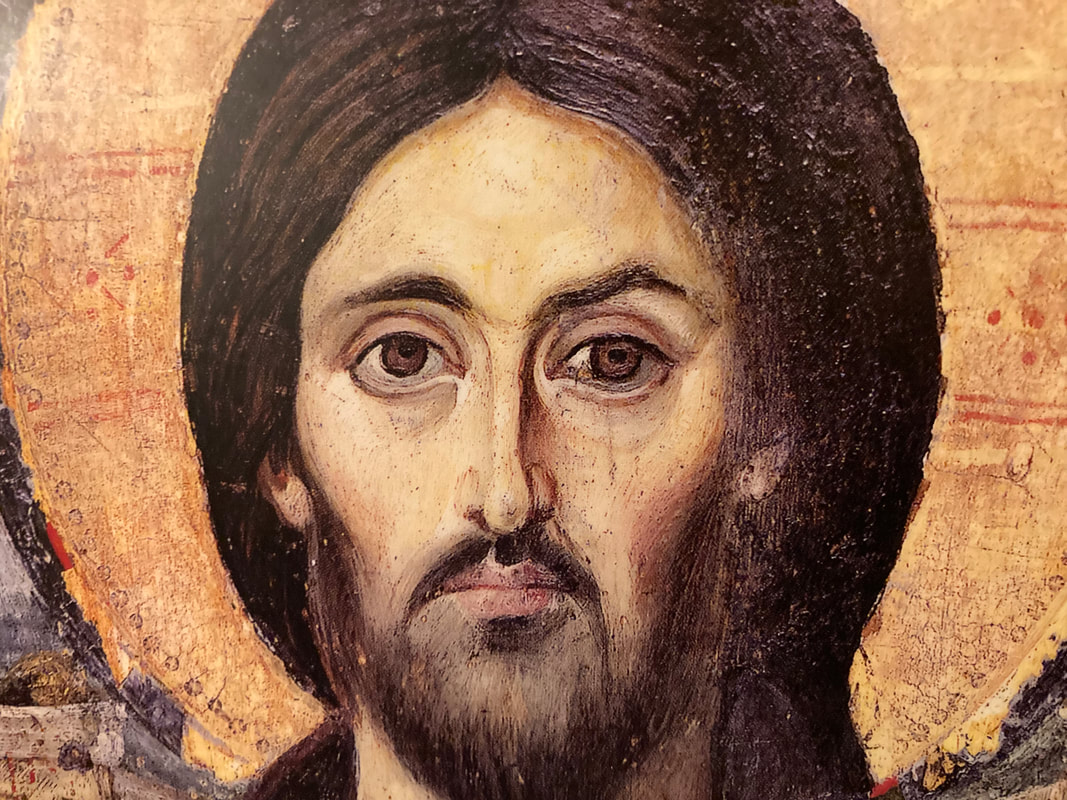"What Are You Looking For?" - Sermon for the Second Sunday After Epiphany (January 15, 2023)1/14/2023 Scripture Readings: Isaiah 49:1–7 | Psalm 40:1–11 | 1 Corinthians 1:1–9 | John 1:29–42
“When Jesus turned and saw them following, he said to them, ‘What are you looking for?’” (John 1:38). What are we looking for? Today is the second Sunday in the Season of Epiphany, a time when we Christians reflect on the mystery revealed to us regarding Jesus Christ our Lord… His divine identity, and divine mission to rescue God’s beloved world. It is a season when the entire unfolding story of God comes to a head in Him, and through Him, we find it carrying on even today… even here in Gondola Point. Even here in this room… inviting you and I to be drawn into His story. That’s why we’re here, after all: in all sorts of ways, we too have drawn near to Jesus. We have seen something in Him, maybe something we do not yet fully understand, but that has still pulled us closer to Him, and closer to each other too. So what is it we’re looking for in Jesus today? And what are we meant to see in Him? These are some of the questions Epiphany invites us to wrestle with. Thankfully, we aren’t the first ones to have done so. Our reading today from the first Chapter of John’s Gospel deals with these very questions, as a part of the Apostle’s careful attempt to open up for us a much wider vision of who Jesus really is… a more ‘complete’ picture of His glory for us to see. But before we get right into what the Apostle John says, we should take a second to look at how he says it… starting with his creative use of the number seven in this first Chapter. In our culture, numbers are usually used in a fairly straightforward way to count and quantify. But in other cultures, numbers can also carry important symbolic meanings. Seven is a very special number in the Jewish imagination, which a number of scholars point out “came to symbolize completeness and perfection.”[1] So, for instance, in Genesis Chapter 1, when God completes creation and rests on the seventh day, this is all highly symbolic imagery for the perfection and wholeness of God’s good world. So whenever seven shows up in the Bible, it’s a big clue that something important is going on… something that asks us to slow down and contemplate to get a more complete picture. And in the Gospel of John Chapter 1, part of which we read today, seven shows up in an interesting way: there are seven titles given to Jesus… six significant, and symbolic names that others give to Him, and one that He uses Himself. This morning, I want us to do something a little different: instead of looking closely at the narrative or context for our readings, I’d like us to slow down and simply spend some time reflecting on each of these seven names St. John gives us in Chapter 1 that together give us a more complete picture of Jesus our Lord. Not all of these seven names turned up in our Gospel reading today. Some came earlier, some later, but they all belong together if we are to see Jesus in all His fullness. The first name comes at the very beginning of John’s Gospel, in verse 1, where He is referred to with the mysterious title: the Word of God. These opening verses intentionally call to mind Genesis Chapter 1, where the Eternal Living God creates everything that is by simply speaking it into being. By calling Jesus the Word of God St. John is making the startling claim right from the start that Jesus shares in the eternal existence of the Divine… that He “was God”, and “was with God”… the same, and yet distinct from the Father in ways that mess with all our categories, but is mysteriously true. As the Word, St. John wants us to see Jesus as both God’s agent of creation, as well as the way God communicates and reveals Himself to the world. As we can share what’s in our hearts by speaking to others, God shares His heart with us through His Word, who took on flesh and shared our human life to make God known. The second title given to Jesus is the one St. John the Baptist proclaimed today in verse 26: “Here is the Lamb of God who takes away the sin of the world!”, he says. And again, in verse 39: “Look, here is the Lamb of God!” The Lamb of God that takes away sin is a reference to an atoning sacrifices some of the most sacred practices of ancient Israel taking part in their Holy Temple. The pure life of a lamb or other chosen animal was sacrificed, in order to restore the shattered relationship between God and His sinful people. This was a sacred means of bringing forgiveness and restoration, instead of destruction… one life laid down to bring life to another… a powerful image of love. These practices, and this title also point us back to the story of Exodus, and the Passover Lamb, whose blood was used to mark the doors of the Israelites in Egypt, so they would be spared from the final plague, and find God’s freedom at last. So for Jesus to be called the Lamb of God that takes away the sins of the World, St. John is calling our attention to the connection between Israel’s sacred sacrifices, and God’s act of deliverance, and the story of Jesus, seeing Him as the one who will be the Ultimate sacrifice, not just to bring freedom and forgiveness to Israel, but to bring freedom and forgiveness to the whole world. Next, in verse 38, we’re told two would be disciples were following Jesus, and in response to His question “What are you looking for?” They said to him, “Rabbi” (which translated means Teacher), “where are you staying?” In some ways, this is a simple enough title: Rabbi… Teacher… an honoured but not uncommon role within the Jewish community as someone who’s duty it is to help God’s people learn, and live in line with the Divine Teachings, also known as Instructions, or Law. That is, the Torah, the Holy Scriptures of the Bible. These disciples see Jesus as a godly Teacher, one who could guide them in God’s ways. And St. John wants us to see Jesus in this light too… but as the supreme Teacher and Guide, not just one voice or opinion among a host of others, but as the one who is the Truth, and longs to make it known. So far, we’ve looked at the first 3 names: the Word of God, the Lamb of God, and Rabbi, or Teacher. The fourth title for Jesus that St. John introduces is the “Anointed One”… which is the Messiah in Hebrew, or in Greek, the Christ. To be anointed was a really big deal. It refers to the sacred ceremony of pouring sacred oil on someone’s head, marking them as chosen, and set apart for God’s holy service, and inviting God’s Spirit to empower them to faithfully fulfill their calling. In Israel, kings and priests, and occasionally prophets alone were anointed, those who were designated to reign, to proclaim God’s word, and to intercede for God’s people. But in time, the term Messiah came to refer to a promised deliverer… a “Chosen One” that God would send as a Saviour to His people, whose whole life would be dedicated to God’s rescue mission. Around the time of Jesus, many were eagerly awaiting the Messiah, imagining that they would come to defeat their enemies, and set Israel on top of the nations. But as St. John wants us to see, it means something else entirely to be God’s true Messiah. Which leads us to the fifth and sixth titles given to Jesus in this Chapter. In verse 49, well after the end of our reading today, but still connected in St. John’s mind, we find an excited Nathaniel, blown away by the small glimpse of glory revealed in His first encounter with Jesus and he blurts out: “Rabbi, you are the Son of God! You are the King of Israel!” These two titles Son of God and King of Israel are deeply connected, and carry more meaning than we might imagine at first glance. First, Son of God suggests a unique, direct, and intimate connection with the Living God. In the Bible, this kind of language is sometimes used to speak of Israel as a whole, imagining God’s covenant people as His beloved but often wayward child. Non-Jewish cultures also made use of language like this. For instance, Caesar in Rome was said to be a “son of the god”, and therefore worthy of devotion and worship. But for St. John, to call Jesus the Son of God is not just a way to stress His Israelite heritage, or to cast Him with the likes of Caesar, as someone using people’s faith as a way to gain prestige and power. For St. John, Jesus is the only true Eternal Son of God, the one who comes from the Father in Heaven, to draw us all into God’s family as adopted sons and daughters, through our faith in Him. Turning now to the sixth title for Jesus: the King of Israel. Again, there are political as well as prophetic dimensions to this name, all wrapped up with God’s promise to the most famous King of Israel: that is, King David. Centuries earlier, God had promised King David that one of his descendants would be raised to the throne, and that his kingdom would never end. Since that time, Israel’s kingdom was divided by civil war, and conquered by Assyria and Babylon, sent into Exile from which only a fraction had returned. And even then, they were oppressed in their own lands by powerful Empires, like the Romans. And yet, God’s promise to David remained a central hope for Israel’s future on this earth… not just someday in heaven, but a future here and now as well. And so, wrapped up with their hopes for the Messiah, were the hopes of a return of God’s good Kingdom… and of an eternal King. Yet for St. John, Jesus is a very different kind of King. One who will indeed rule forever, but who would first be executed like the lowest criminal. At the climax of John’s Gospel, Jesus is arrested, falsely accused, unjustly sentenced to death, tortured and mocked mercilessly, with the soldiers making him a crown of thorns, and hailing Him “King of the Jews”, which is what the Roman Governor, Pontius Pilate has inscribed on a sign above Jesus’ head as he hung naked and dying in agony on the cross. No one would look at Jesus on the cross and see a King. And yet, that is the amazing truth St. John is inviting us to believe… to see in the cross, not defeat, but the beginning of Jesus’ eternal reign: suffering and dying to bring about God’s good Kingdom at last. This leads us to the seventh and last name applied to Jesus in John Chapter 1. The name He most frequently uses for Himself: the Son of Man. In one sense, this name means ‘mortal’, or ‘human one’, a descendant of the race of Adam & Eve, who were given the chance to share God’s eternal life, but chose instead to listen to the Serpent, that symbol of spiritual rebellion and evil at work in our world, and found themselves under death’s thumb. But in this same story from Genesis God offers hope to His beloved but now broken human creations: He promised that one day, a descendant of Eve would finally crush the head of the Serpent, that instigator of evil, once and for all… even though he would also be bitten by the Serpent in the process. In other words, the promised Saviour of the human race would win the victory through suffering. This promised suffering but victorious Son of Man is a theme that runs all through the story of Scripture, and from the outset of His ministry, Jesus uses this name, identifying with us in our weakness and vulnerability, but also pointing forward to His role as the promised suffering Saviour. All this and more is meant to be brought to mind by the seven names of Jesus in John Chapter 1. From the start of his Gospel St. John wants us to see that Jesus is all of these things at once… not only back then, two millennia ago, but today as well! Jesus is the Word of God… the One who shared in the Creation of all that is, and who has made known God’s own character and heart. In our times of chaos and darkness, we can look to Jesus and find God’s eternal, life-giving word bringing order, beauty, and light, and making all things new. Jesus is the Lamb of God… who laid down His life to deal with the sins of the whole world once and for all at the cross. In our times of failure, regret, and shame, we can look to Jesus and find He has revealed God’s love for us, in that while we were still sinners, He died… not just for the whole world, but for you and me… to cleanse and set us free from our sins and wickedness… and to pour out on us God’s gracious forgiveness, reconciliation, and peace. Jesus is the great Teacher. In our times of doubt, as the truth we need seems harder and harder to comprehend, we can look to Jesus and find the One who still truly shows us God’s holy ways… the One who is Himself the truth, and who leads us into life. Jesus is the Messiah, the Christ… the Anointed One, set apart for God’s mission. In our times of confusion and uncertainty, we can look to Jesus and find Him completely dedicated to doing God’s will, and bringing God’s deliverance to us all. Jesus is the Son of God… uniquely sharing in His self-giving life. In our times of being pushed around by those who hunger for positions and power, we can look to Jesus and find the one who truly embodies God’s greatness… by caring for the outcasts, the hurting, the powerless… by seeking and saving the lost. Jesus is the King of Kings, the One who reigns even now at God’s right hand. In our times of being caught up in the conflicts and struggles of our days, where we are pulled in a hundred directions by those who demand that we give them our loyalty, we can look to Jesus and find God’s good Kingdom at work even now in our lives: the Kingdom whose victory was won by Jesus’ self-giving love on the cross even for His enemies… the only Kingdom that will endure forever. Jesus is the Son of Man, stepping into our mortal human existence, and sharing in all our sufferings. In our times of fear and fragility, even as we face the shadow of death, we can look to Jesus and find the one who confronted the powers of death, and endured it’s worst at the cross, only to be raised again as the firstborn of God’s New Creation… and who will raise us up with Him, to share in His risen life for all eternity. Jesus is all this at once… and more! Even when we don’t understand Him all. And thankfully, just like John the Baptist, and the first disciples in John’s Gospel… we aren’t meant to understand it all right from the start. No, just like them, we just catch a glimpse of Jesus… we hear a hint of His mission… a whisper of His story… and that is enough to draw us closer… only to find Him looking at us and inviting each of us to follow Him… to “come and see” even more… “What are you looking for?” Jesus asked those first disciples. And He asks you and I the same thing this morning: “What are we looking for in Him?” This is His invitation to follow. To draw near to Him in faith, and find that He is far more than we could have ever imagined, and that He has more in store for you and I as we follow Him too. Like St. John, we too can come to experience Jesus in all of His fullness. And like St. John, we can with confidence invite others to do the same. Whatever we started off looking for in Jesus, may we find in Him the fullness of God’s great gift of love to us and our world. Amen. [1] Joel F. Drinkard Jr., “Number Systems and Number Symbolism,” ed. Chad Brand et al., Holman Illustrated Bible Dictionary (Nashville, TN: Holman Bible Publishers, 2003), 1199.
0 Comments
Your comment will be posted after it is approved.
Leave a Reply. |
Rev. RObRev. Rob serves as the Priest-in-Charge at St. Luke's Gondola Point, and as the School Chaplain at Rothesay Netherwood School Archives
June 2024
Categories
All
|
|
5 Quispamsis Road, Quispamsis NB, E2E 1M2
Mail to: 12 Quispamsis Road, Quispamsis NB E2E 1M2 |
Contact Us
Parish Phone: 506-847-3670 | www.stlukesgp.ca | www.facebook.com/StLukesGP/ Rev. Rob: 506-608-1772 | [email protected] |
Proudly powered by Weebly


 RSS Feed
RSS Feed
